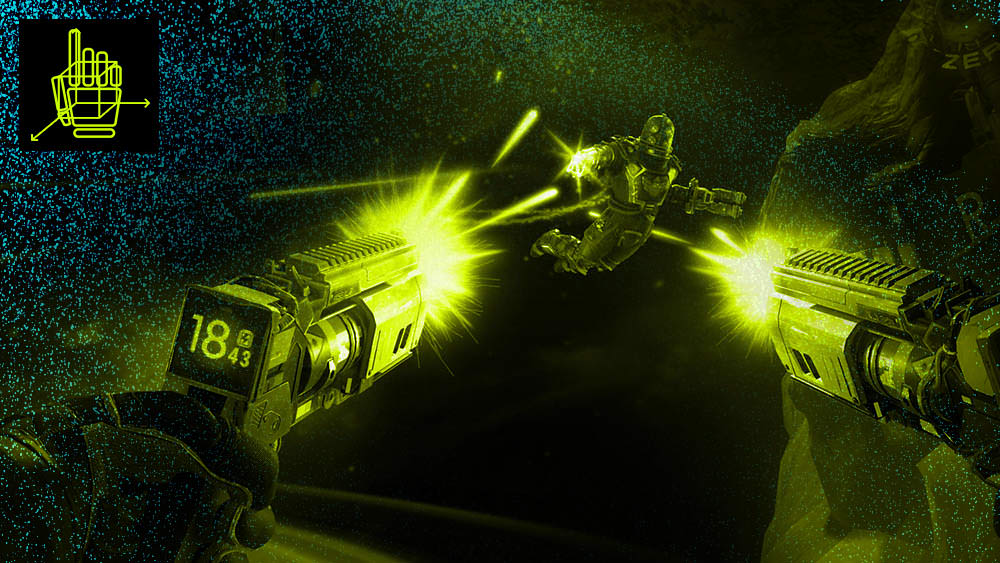
Ubisoft is one of the biggest proponents of VR gaming—perhaps more so than almost any other major publisher. With several VR titles that include the fast-paced Eagle Flight, the social game Werewolves Within and the upcoming action-shooter Space Junkies, it seems clear that the publisher is looking to create a wide range of experiences for Oculus Rift, HTC Vive and PlayStation VR.
The publisher is also using VR to bridge the worlds of film and video games, having helped create the Assassin’s Creed VR experience to promote the movie last year, and to a certain extent with Star Trek: Bridge Crew, which is based on the hit IP.
Ubisoft is currently working with Elijah Wood’s film company SpectreVision to develop Transference—a psychological thriller where players explore the memories of PTSD patients.
AListDaily spoke with Chris Early, VP of partnerships and revenues at Ubisoft, to discuss the company’s interest in the technology and where it might go.
What are Ubisoft’s goals with VR?
Overall, our goal is to provide amazing entertainment experiences for our players. VR is one of those places where we’re interested in figuring out how to do that and what opportunities might exist.
If you’re familiar with Ubisoft’s history, you’ll see that we’re generally early adopters of new technologies for gaming and entertainment. We use that curiosity and creativity to look at new ways we can bring new experiences to our customers.
In the past, we’ve done things with motion gaming, which led to Just Dance. We were convinced that there was more than just Wiimote-style motion gaming. We believe that there are new ways of telling stories and experiencing games.
Our efforts in VR are to that end—providing great experiences for our players.
How does promoting a VR game compare to traditional ones?
One of the challenges with promoting a VR game is that you can’t easily watch the experience. For example, we have Eagle Flight, which is a game where you fly above the city of Paris as an eagle. You can watch a video of that, but it doesn’t convey the full sense of the experience.
So, in many cases, the promotion and sale of a VR game happens when you put a headset on. But because there’s a limited distribution of headsets in the world and not a lot of places to try them out, it’s more of a challenge to promote the game.
Why isn’t Ubisoft linking its VR games with more of its established franchises?
Our focus in the VR space has been to look at what’s fun. A variety of our studios are engaged in trying new game mechanics and what fits with existing game mechanics. So, we do look at a wide variety of things, and Eagle Flight is an example of one of the mechanics we were experimenting with. You know, it’s pretty darn fun to fly around as a bird in VR. So, that went from a tech experiment, to a game pitch, to development and release.
“You know, it’s pretty darn fun to fly around as a bird in VR. So, that went from a tech experiment, to a game pitch, to development and release.”
We’ve also looked at other things, like experimenting with VR with Far Cry 3 (Vaas VR), and that was intense and compelling, but we don’t have that integrated into a game at this point in time.
From our standpoint, we’re not ruling anything out, nor are we saying that that has to be the way that we do it. We’re experimenting and looking at what’s going to be fun. We believe that there’s newness here and we want to be sure we’re not going in with preconceived notions.
A good example is Star Trek: Bridge Crew and Werewolves Within, both of which are highly social games. We’ve learned a lot about social interaction in VR, which is something that we’ve brought back to our regular games. Had we used a traditional approach in gaming, we wouldn’t have ended up with as good of products as we had.
Do you think bringing in IPs like Star Trek is the key to popularizing VR technology?
I think that well-known IPs are a good way to have people instantly recognize what the content might be like in a VR game. With the intense passion and loyalty around the Star Trek franchise, are there people who probably bought VR headsets just so they could play Bridge Crew? I believe that there are. But is it necessary to have that? I don’t think so.
We see good adoption of Eagle Flight because the concept of being able to fly is something people understand. But the further away you get from easily understood concepts, the more a brand can help generate awareness and interest.
Many people see VR as a solitary experience. What is the strategy behind making multiplayer games in VR?
Yes, most people imagine using VR in a dark, isolated environment, but that’s not the way we’ve approached this. We looked at it from the standpoint of what would make the VR experience fun.
Our Red Storm studio in particular is focused on social VR—looking for ways to enhance social dynamics in play—and that’s where both Werewolves Within and Star Trek: Bridge Crew were developed.
People have more fun playing with people. The industry thought that VR was a solitary experience, yet when we look at our usage tracking, we see that the longer play sessions come from when people are playing in multiplayer modes. People enjoy the interaction that takes place in VR at a social level, and I think that’s partly because of the innovations that we’ve brought about that make it easy to communicate in VR along with game-oriented reasons to encourage communication.
People have more fun playing with people.
These are cooperative or conversational games. Eagle Flight has a multiplayer element, the same way any other shooter, because it’s better to take on a real person than a computer. I don’t think VR necessarily makes it more fun, it’s the human interaction that does.
What led to the partnership with SpectreVision to develop Transference?
We have a deep respect for the writing and intensity that SpectreVision brings to the properties it works on. As we think about VR and its possibilities, we saw with the Far Cry 3 experiment that it was possible to have intense emotional experiences in VR—much more than we thought to begin with. That’s what eventually led to a collaboration.
We showed Transference behind closed doors at E3, and the people who went through the experience were genuinely impressed, particularly how it can be unsettling and terrifying without being too graphic. We’ve taken more of a thriller and suspense approach as opposed to gory and gruesome, which I think has broader appeal for folks.
Does Ubisoft have a unifying approach or theme when deciding which VR games to develop?
The theme that ties both our VR and non-VR content together is fun. Ubisoft does not have a portfolio strategy where we say we have to have one type of VR game or any other type of game.
What we do—and do well—is allow our game developers to be creative and come up with the ideas for games they want to make. We find that as a result of that, they’re more passionate about making them. They make better games than if there were a dictate. As a result, we will end up with games that are fun.
We won’t greenlight a game that we don’t think will be entertaining. That could be said for any variety of games, including a space shooter like Space Junkies, a tabletop game like Werewolves Within, or a flying game like Eagle Flight. None of them are tied together through a portfolio or a franchise concept. It’s more that these are fun game mechanics that people enjoy playing.
Eagle Flight has been featured at VR arcades. Does Ubisoft keep location-based experiences in mind with its games?
We’ve done both. In the case of Eagle Flight, it’s something that adapts well to both environments. We also have a VR ride based on the Rabbids franchise, which was developed specifically for location-based entertainment, and uses a motion chair along with a VR headset. You could potentially play Werewolves Within in an arcade, but it’s not designed for a theater-front experience.
Again, we focus not on prescribed solutions, but more on where it’s going to work.
What is Ubisoft’s bar for success when it comes to VR?
I would say that we generally focus on what player’s experiences are. There are several ratings around VR games, so we look at them along with fan commentary and game play [time].
It’s amazing to see that our games have some of the highest amounts of game play of any VR game out there. To us, that’s a good mark of success—when people are in headsets for hours at a time playing games, far exceeding our expectations and industry averages. Apparently, we’ve done something right and people are having a good time.
What do you think is in store for VR and how is Ubisoft helping to shape it?
I think we’re all participating in the future of VR, and nobody knows where it’s going to end up. That’s part of the reason why we’re experimenting with new ways of telling stories and new paradigms in the VR space. There are some things that are much easier in VR, some things that are much more difficult, and we don’t know where it’ll go.
We learned a great deal about in-headset communication, and how to make people more comfortable in fast-motion games. Both Eagle Flight and Space Junkies are fast-motion, and we don’t see anywhere near the same level of discomfort that some people experience in other games.
But from an overall standpoint, as we continue to drive creativity in the VR space, our hope is that we and other publishers continue to produce good products in VR. As time goes on, more people will have headsets and the chance to experience VR, and it will become a strong part of our industry.

